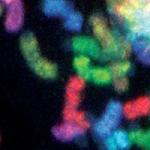
Adam M. Phillippy, Ph.D.
Senior Investigator
Computational and Statistical Genomics Branch
NHGRI
Research Topics
The Genome Informatics Section develops and applies computational methods for the analysis of massive genomics datasets, focusing on the challenges of genome sequencing and comparative genomics. As one example, high-quality reference genomes form a fundamental basis of all genomics research, but the construction of these references, known as genome sequencing and assembly, is an error-prone process that can affect the accuracy of all downstream analyses. The section aims to improve such foundational processes and translate emerging genomic technologies into practice.
Bioinformatics has a long history of bridging fields, and the incredible growth of genomics has been inextricably linked to advances in algorithms and computing. Recognizing this, the section specializes in the development of methods for new genomic technologies and seeks to foster open and interdisciplinary collaboration between the computational, biological, and medical sciences for the advancement of global health. Members of the section are at the forefront of these fields and have made key contributions to the development of DNA sequencing and analysis technologies.
Another major focus of the section is the development of genomic resources such as the human reference genome. From its initial release in 2000 through 2022, the human reference genome has covered only the euchromatic fraction of the genome, leaving important heterochromatic regions unfinished. Addressing this remaining 8% of the genome, the section assembled the first truly complete sequence of a human genome in 2022, unlocking all regions of the genome to variational and functional studies for the first time. However, this complete genome represents only a single haplotype and does not capture the full diversity of human genomes. This limitation can affect the accuracy of all genomic analyses, especially for underrepresented variants and populations. For the benefits of personalized genomics to be inclusive of everyone, the section is now working towards extending the human reference to a pangenome that is more representative of genomic variation.
Lastly, characterizing genomic variation and innovation across all species, not just human, is critical for fully understanding and reverse-engineering life's genomic code. The section's development of new sequencing and assembly technologies has resulted in a flood of complete genomes from across the tree of life, which are being used to study the functional, comparative, and population genomics of multiple species at unprecedented resolution. Even for well-studied species, the de novo assembly of multiple individuals can reveal complex structural variation missed by re-sequencing approaches. Our current projects include completing the genomes of non-human primates to better understand our own evolution; agricultural species to improve their health and resiliency; and endangered species to create an indelible record of the world's genomic biodiversity.
Biography
Dr. Adam Phillippy is a Senior Investigator and head of the Genome Informatics Section at the National Human Genome Research Institute. His lab develops and applies computational methods for the analysis of massive genomics datasets, focusing on the challenges of genome sequencing and comparative genomics. He is a pioneer of single-molecule sequencing for the reconstruction of complete genomes and is best known for his work on completing the human genome from "telomere to telomere".
As a bioinformatician who bridges the fields of computer science and genomics, Dr. Phillippy has developed numerous widely-used tools for genome assembly, comparative genomics, microbial forensics, and metagenomics. Early in his career at The Institute for Genomic Research, he developed algorithms for whole-genome alignment that were used by the FBI to trace the origin of the 2001 anthrax attacks. After completing his Ph.D. in 2010, he founded a bioinformatics group at the National Bioforensic Analysis Center and pioneered the use of single-molecule sequencing for the reconstruction of complete microbial genomes. In 2015, he joined NHGRI and shifted his focus to human and vertebrate genomics. Since then, his group has assembled hundreds of reference genomes for humans, animals, and plants, including important endangered and agricultural species. In 2022, his team published the first truly complete sequence of a human genome, revealing over 200 million bases of additional sequence and enabling new studies of genomic function and disease.
Dr. Phillippy received his B.S. in computer science from Loyola University Maryland under the advising of Dr. Arthur Delcher and his M.S. and Ph.D. in computer science from the University of Maryland with Dr. Steven Salzberg. He is a recipient of the U.S. Presidential Early Career Award for Scientists and Engineers, the NIH Director's Award, the Ilchun Molecular Medicine Award from the Korean Society for Biochemistry and Molecular Biology, and a distinguished alumni award from Loyola University Maryland. He was named by TIME magazine as one of the world's most influential people of 2022 for his work on completing the human genome.
Selected Publications
- Nurk S, Koren S, Rhie A, Rautiainen M, Bzikadze AV, Mikheenko A, Vollger MR, Altemose N, Uralsky L, Gershman A, Aganezov S, Hoyt SJ, Diekhans M, Logsdon GA, Alonge M, Antonarakis SE, Borchers M, Bouffard GG, Brooks SY, Caldas GV, Chen NC, Cheng H, Chin CS, Chow W, de Lima LG, Dishuck PC, Durbin R, Dvorkina T, Fiddes IT, Formenti G, Fulton RS, Fungtammasan A, Garrison E, Grady PGS, Graves-Lindsay TA, Hall IM, Hansen NF, Hartley GA, Haukness M, Howe K, Hunkapiller MW, Jain C, Jain M, Jarvis ED, Kerpedjiev P, Kirsche M, Kolmogorov M, Korlach J, Kremitzki M, Li H, Maduro VV, Marschall T, McCartney AM, McDaniel J, Miller DE, Mullikin JC, Myers EW, Olson ND, Paten B, Peluso P, Pevzner PA, Porubsky D, Potapova T, Rogaev EI, Rosenfeld JA, Salzberg SL, Schneider VA, Sedlazeck FJ, Shafin K, Shew CJ, Shumate A, Sims Y, Smit AFA, Soto DC, Sović I, Storer JM, Streets A, Sullivan BA, Thibaud-Nissen F, Torrance J, Wagner J, Walenz BP, Wenger A, Wood JMD, Xiao C, Yan SM, Young AC, Zarate S, Surti U, McCoy RC, Dennis MY, Alexandrov IA, Gerton JL, O'Neill RJ, Timp W, Zook JM, Schatz MC, Eichler EE, Miga KH, Phillippy AM. The complete sequence of a human genome. Science. 2022;376(6588):44-53.
- Rhie A, Nurk S, Cechova M, Hoyt SJ, Taylor DJ, Altemose N, Hook PW, Koren S, Rautiainen M, Alexandrov IA, Allen J, Asri M, Bzikadze AV, Chen NC, Chin CS, Diekhans M, Flicek P, Formenti G, Fungtammasan A, Garcia Giron C, Garrison E, Gershman A, Gerton JL, Grady PGS, Guarracino A, Haggerty L, Halabian R, Hansen NF, Harris R, Hartley GA, Harvey WT, Haukness M, Heinz J, Hourlier T, Hubley RM, Hunt SE, Hwang S, Jain M, Kesharwani RK, Lewis AP, Li H, Logsdon GA, Lucas JK, Makalowski W, Markovic C, Martin FJ, Mc Cartney AM, McCoy RC, McDaniel J, McNulty BM, Medvedev P, Mikheenko A, Munson KM, Murphy TD, Olsen HE, Olson ND, Paulin LF, Porubsky D, Potapova T, Ryabov F, Salzberg SL, Sauria MEG, Sedlazeck FJ, Shafin K, Shepelev VA, Shumate A, Storer JM, Surapaneni L, Taravella Oill AM, Thibaud-Nissen F, Timp W, Tomaszkiewicz M, Vollger MR, Walenz BP, Watwood AC, Weissensteiner MH, Wenger AM, Wilson MA, Zarate S, Zhu Y, Zook JM, Eichler EE, O'Neill RJ, Schatz MC, Miga KH, Makova KD, Phillippy AM. The complete sequence of a human Y chromosome. Nature. 2023;621(7978):344-354.
- Rautiainen M, Nurk S, Walenz BP, Logsdon GA, Porubsky D, Rhie A, Eichler EE, Phillippy AM, Koren S. Telomere-to-telomere assembly of diploid chromosomes with Verkko. Nat Biotechnol. 2023;41(10):1474-1482.
- Rhie A, McCarthy SA, Fedrigo O, Damas J, Formenti G, Koren S, Uliano-Silva M, Chow W, Fungtammasan A, Kim J, Lee C, Ko BJ, Chaisson M, Gedman GL, Cantin LJ, Thibaud-Nissen F, Haggerty L, Bista I, Smith M, Haase B, Mountcastle J, Winkler S, Paez S, Howard J, Vernes SC, Lama TM, Grutzner F, Warren WC, Balakrishnan CN, Burt D, George JM, Biegler MT, Iorns D, Digby A, Eason D, Robertson B, Edwards T, Wilkinson M, Turner G, Meyer A, Kautt AF, Franchini P, Detrich HW 3rd, Svardal H, Wagner M, Naylor GJP, Pippel M, Malinsky M, Mooney M, Simbirsky M, Hannigan BT, Pesout T, Houck M, Misuraca A, Kingan SB, Hall R, Kronenberg Z, Sović I, Dunn C, Ning Z, Hastie A, Lee J, Selvaraj S, Green RE, Putnam NH, Gut I, Ghurye J, Garrison E, Sims Y, Collins J, Pelan S, Torrance J, Tracey A, Wood J, Dagnew RE, Guan D, London SE, Clayton DF, Mello CV, Friedrich SR, Lovell PV, Osipova E, Al-Ajli FO, Secomandi S, Kim H, Theofanopoulou C, Hiller M, Zhou Y, Harris RS, Makova KD, Medvedev P, Hoffman J, Masterson P, Clark K, Martin F, Howe K, Flicek P, Walenz BP, Kwak W, Clawson H, Diekhans M, Nassar L, Paten B, Kraus RHS, Crawford AJ, Gilbert MTP, Zhang G, Venkatesh B, Murphy RW, Koepfli KP, Shapiro B, Johnson WE, Di Palma F, Marques-Bonet T, Teeling EC, Warnow T, Graves JM, Ryder OA, Haussler D, O'Brien SJ, Korlach J, Lewin HA, Howe K, Myers EW, Durbin R, Phillippy AM, Jarvis ED. Towards complete and error-free genome assemblies of all vertebrate species. Nature. 2021;592(7856):737-746.
- Ondov BD, Treangen TJ, Melsted P, Mallonee AB, Bergman NH, Koren S, Phillippy AM. Mash: fast genome and metagenome distance estimation using MinHash. Genome Biol. 2016;17(1):132.
Related Scientific Focus Areas
This page was last updated on Monday, August 26, 2024


